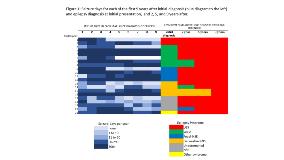Evolution and Course of Lennox-Gastaut Syndrome: Opportunities for Prevention?
Abstract number :
1.200
Submission category :
4. Clinical Epilepsy / 4A. Classification and Syndromes
Year :
2018
Submission ID :
501121
Source :
www.aesnet.org
Presentation date :
12/1/2018 6:00:00 PM
Published date :
Nov 5, 2018, 18:00 PM
Authors :
Anne T. Berg, Ann & Robert H. Lurie Children's Hospital of Chicago; Susan Levy, Yale University School of Medicine; and Francine Testa, Yale University School of Medicine
Rationale: Lennox-Gastaut (LGS) is one of the most serious forms of epilepsy and arises during the first few years of life. Little is known about its epidemiology, presentation and evolution, yet such information is critical to early intervention efforts aimed at preventing LGS from occurring and mitigating its course. Methods: The Connecticut Study of Epilepsy (CSE), prospectively recruited a community-based cohort of children (ages 0-15) with newly diagnosed epilepsy from 1993-1997 and followed them through 2014. Children diagnosed with LGS were identified based upon their syndromic diagnosis at initial presentation and as re-evaluated 2, 5, and 9 years later. Seizure occurrence and use of seizure medications were documented during quarterly phone calls with parents and periodic review of medical records. The evolution of the syndromic presentation, mortality, and seizure course were charted over time. Results: Twenty-one of 613 (3.4%) children were diagnosed with LGS initially or over the course of follow-up (median=15y). Average age at initial epilepsy onset was 1.4y (SD=1.3), maximum=5.3y. Underlying etiologies were unknown in 12 (in the pre-genetic testing era). Only 2/21 children were diagnosed with LGS as their initial form of epilepsy; initial epilepsy diagnoses were West Syndrome (N=6, WS), Doose (N=1), and nonsyndromic epilepsies (NSE) with focal (N=11), generalized (N=11) and undetermined (N=4) features. By 2, 5, and 9 years later, 16, 20 and 21 carried the LGS diagnosis. In 19 later diagnosed with LGS, the average age at LGS diagnosis was 3.6y (SD=2.0) and the average lag-time from initial epilepsy presentation to LGS diagnosis was 2.2 years (SD=2.2, range 1m to 7y). All 21 were intellectually disabled when assessed later in adolescence. Plots of seizure days per year over the first nine years demonstrated an extremely high seizure burden with most children having weekly to near daily seizures over most of the first several years. Some children, though, did have one or more years seizure-free (Figure). Conclusions: The epidemiological literature suggests that there are 800-1000 newly-diagnosed cases of LGS each year in the US, although only a fraction of those are diagnosed as LGS from the start. Most children present either with WS or a nonsyndromic epilepsy. Since the 1990s when this cohort was first identified and despite the advances in diagnostic testing and therapeutic options, there have been few evidence-based changes in the approaches to early life epilepsies. There are no systematic efforts to identify those at risk of developing LGS even though most children who develop LGS first present with another form of early-life epilepsy. Investigation into the clinical evolution and prediction of LGS in young patients with West and NSE is a necessary next step for developing strategies to prevent LGS from ever developing. Funding: NIH-R37-NS31146
